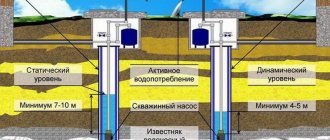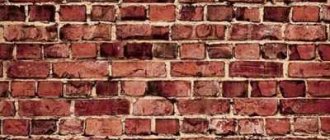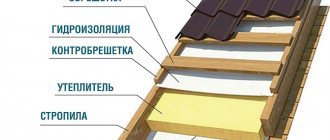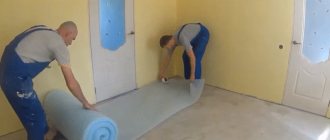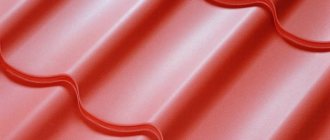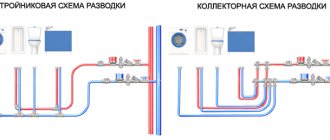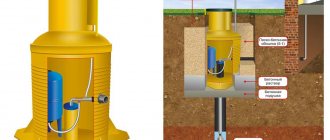In private households, they often choose their own source of liquid supply. This may be more economical than connecting to a centralized water supply, or the only possible option in a given area. Many believe that the liquid from its source is softer and more suitable for drinking, since it does not undergo chlorination and treatment with other chemicals, but only if mechanical filters are correctly installed to purify water for a well at home.
When is filtering necessary?
The answer will be the same - always. But the degree of purification can be different; in some cases, only mechanical removal of contaminants is necessary, and in others, getting rid of chemical impurities, when the composition does not meet the requirements of SanPiN and other standards.
In both cases, first of all, they suggest installing a deep cleaning filter, which simultaneously has two current tasks:
- prevents the ingress of coarse particles: sand, clay, pebbles, etc.;
- protects equipment from premature damage and wear.
We draw your attention to the fact that small inclusions of soil that can get into your home water supply will not only spoil the taste of food and can harm your health, but also negatively affect the shut-off valves and the pipes themselves. All pipeline elements become clogged and soon deteriorate and break.
This filtration element is called the first stage. But to use well water, you must not only clean it of impurities, but also determine its chemical composition.
Despite the fact that a well is considered a more preferable and safer option than a well, since the latter source is open and the former is closed, it may also contain impurities that are undesirable for drinking.
The amount and type of suspended particles mainly depends on the soil, site, and the immersion depth of the pumping equipment. Typically, the depth of immersion depends on the depth and type of water supply. There are these options:
- Abyssinian well - high purity, low mineralization, but the presence of nitrites, nitrates, ammonia, pesticides is possible, especially if the soil has been pre-treated with chemicals or there are agricultural land plots nearby.
- A well for sand is a more often used option, because the quality of the liquid is practically not affected by the condition of the earth above. In addition, mineralization is even lower than that of the Abyssinian. However, there may be impurities from substances such as iron and calcium, as well as some pathogenic microorganisms.
- An artesian source is the deepest, best option. It is often used as drinking water, because the microbiological composition almost always excludes harmful substances. But there is also a minus - there can be a lot of mineral parts due to possible deposits of mineral deposits in the layers of the earth. These are, first of all, hardness salts, inorganic iron and manganese. This leads to a brown or even black coating remaining on the dishes after settling or boiling.
Thus, we conclude that, regardless of the type of water source, it is necessary to submit samples for analysis to determine the type of filtration of water from a well in a private house.
During such a test the following indicators are determined:
- presence of color or transparency;
- cloudiness;
- the amount of iron and other metal and non-metal impurities;
- oxidation level;
- degree of alkalinity;
- pH balance;
- presence of microorganisms and their concentration.
All this data will help you understand how bad or good the quality of the liquid is, and whether it can be used, including for drinking purposes. And what kind of filtration is needed.
Another reason is a decrease in hardness or, in other words, softening. It is necessary for everyone who plans to use any heating devices. And this is not only a kettle, but also heating elements in boilers, as well as in various household appliances (washing machines, dishwashers). Heating elements with increased hardness quickly become covered with scale.
To get rid of the above reasons, you need to install an additional water filtration system from the well. Such filters solve the following problems:
- Removes harmful toxins.
- They cope with organic matter - the main cause of infections and diseases.
- Soften the liquid.
- They make it tastier - without a salty or sharp, sour taste or smell.
- They will make it safe for drinking.
- Remove +2 and +3 iron from water.
Do-it-yourself water purification systems from a well
One of the options for homemade water purification from a well using the aeration method is demonstrated in the photo below. Two stages of aeration are used here to more completely purify the water and remove all impurities. The need for the second stage is determined based on the results of cleaning the first stage: the quality is not always satisfactory. Repeated aeration can help with this, but this is far from the only solution: you can install one of the filters. He will do a good job and rarely score.
Two-stage well water purification system
In this option, water from the well is supplied through shower heads. In this way, primary oxygen enrichment occurs. There is also a submersible sprayer from an aquarium compressor. The water level is controlled by a float switch (used to control the water in the pool). At the bottom of the container there is a tap for draining settled substances.
From the first container, water is drawn in the same way as in the previous version, from the lower third. the system there is organized similarly. From there, water can be supplied to a final cleaning and disinfection filter, and then distributed throughout the house.
For another example of a homemade well water purification system, see the video.
The best types of systems
After chemical analysis, a choice must be made. Another criterion is where the source itself is located and how deep the drilling was. Let's look at the filter options.
Gravel
MBFT-75 Membrane for 75GPD
SF-mix Clack up to 0.8 m3/h
SF-mix Runxin up to 0.8 m3/h
It is called the simplest and at the same time inexpensive. Its main task is to prevent the penetration of large soil particles into the water supply system, that is, fairly rough cleaning is carried out. What conditions are needed to install the system:
- It is necessary to prepare pipes of a smaller diameter than the outlet of the well pump;
- Gravel pebbles should be small to retain smaller particles;
- The gravel layer should be large enough - from 90 cm to 2 meters.
It should be noted that if the well is located in an area where the soil is predominantly sand, rapid clogging will occur, so it is better to install a second protection, for example, a mesh.
Let's highlight the advantages:
- Simple and practical design.
- Protection of downhole instruments from rust.
- The ground is fixed and protected from landslides.
- The system is completely natural, so you don’t have to worry about the safety of its use and the taste of the purified liquid.
Mesh filter for water well: features, how to choose
It is considered one of the most effective and applicable on sandy rocks, because with its help the smallest particles of contaminants are retained. Inside there is a grid of tiny cells, which can have a shape - square, keeper, galloon, or multilayer. To choose the right nozzle, you first need to do an analysis - it determines what size the minimum fractions of impurities are. Based on this, the best option is selected from 0.12 to 3 square millimeters.
When purchasing, it is worth noting that high-quality products are made only from stainless steel to prevent corrosion. They have a service life of up to 50 years. In this case, dimensional units are determined in the number of vertical and horizontal wires per cell, for example, 6/40.
Advantages:
- good quality – the smallest particles are retained;
- ease of installation and repair;
- if several torn areas appear, the filtration result will remain virtually unchanged.
There are also disadvantages, for example:
- manufacturing materials are quite expensive;
- When used, the liquid pressure decreases.
Slotted
This is another option for what filters are installed on wells, especially if they are located on soil that is prone to collapse. These types include sand, pebbles and crushed stone.
Pros:
- retains rock particles of quite different sizes;
- ideal when you need to handle a small pressure;
- the perforated pipe that underlies the system can experience high pressure, since it is made of durable material;
- low price.
The downside is that since the slots are quite narrow, they quickly become clogged and need to be cleaned. In addition, the harder the water, the more there should be.
Perforated (holey)
This is one of the subtypes of the previous filter, with the same design, but the shape of the holes is different - a small number of them on the pipe itself + mesh. This makes it more stable, even in deep wells. But the throughput is quite low - the flow becomes smaller, this is due to the fact that it is necessary to overcome double protection.
AMETHYST - 02 M Residential building for up to 10 people or up to 2 cubic meters/day.
Aeration unit AS-1054 VO-90
Main table dispenser AquaPro 919H/RO (hot and cold water)
Wire
Essentially, this is a good combination of three types, that is, the product consists of:
- a sump through which liquid passes;
- perforated pipe, as in a slotted one;
- wire mesh like mesh.
They have a very long service life due to the fact that wire is used - it is more reliable than a mesh network, does not rust and can last up to 30 years without problems. However, there is a big drawback - the size of the structure. Due to its dimensions and, in general, complex configuration, it is almost impossible to remove it for cleaning, repair or dismantling and subsequent reinstallation in another location.
Types of mechanical cleaning filters
Based on the type of filter element, mechanical filters are divided into two main types:
- mesh;
- cartridge
Strainers
These are universal coarse filters. The compact device is based on a mesh with a cell of 90-100 microns (the optimal size for high-quality filtration, such a cell does not clog so quickly), installed in the outlet through which water is supplied. These filters, although small in size, are characterized by high throughput and are quite effective against sand, rust particles and other mechanical impurities. During operation, regular cleaning of the mesh by washing is required, and the frequency of replacing the mesh depends on the degree of water contamination. Modern devices are equipped with a special fitting. There is no need to disassemble the filter for washing, which greatly simplifies water treatment.
Oleg Panin
Filter mesh units with manual washing are equipped with a special valve; washing can be direct or reverse. Flushing clears the walls and the mesh itself of accumulated solids, removing sediment in just a few minutes. This allows the filter unit to be used for a long time without replacement or additional maintenance.
Mesh filters for cold water are usually equipped with a transparent body made of high-strength plastic, so contamination can be monitored visually. Filters for hot water supply are made in a metal casing, and it is convenient to use a pressure gauge to monitor the condition of the mesh. In addition, some filter models are equipped with a reducer that maintains the pressure level after the filter, which protects plumbing fixtures and equipment from pressure drops in the line.
Cartridge filters
They are used for purifying cold water; a polypropylene cartridge is installed in the flask as a filter element. Solid impurities settle in the volume of the filter element, which must be changed as it becomes dirty. Cartridge filters cope with particles smaller than mesh filters (up to 1 micron), but also larger, which can complicate their installation in a typical apartment.
Cleaning options
There are three stages of water treatment, they consist of:
- mechanical cleaning;
- chemical filtration (absorption);
- disinfection.
Let's talk in more detail about them.
Primary water filtration
It is necessary for any source, and it does not matter how it will be used. It is designed to trap areas of silt, sand, rocks and any debris that may end up in the garbage disposal. The options listed above (gravel, crevice, wire) refer specifically to rough cleaning.
Deep water treatment systems
Installation of such equipment is necessary in country houses or cottages that are installed in areas with a high content of salts or other impurities in the soil. This is easy to determine - you need to submit the fluid from the well for examination and determine its composition. Also included in this category are types that are intended for disinfection, that is, to eliminate any bacteria that are in the liquid.
We list the methods of deep water purification:
- Ion exchange filtration. The ion exchange method is based on the ability of certain substances to change their ionic composition. Magnesium and calcium ions are retained, and in return the water is enriched with sodium ions. The resulting salts are not deposited as scale and do not have a negative effect on humans.
- Membrane. H2O molecules are very small in relation to any impurities, so they pass further through the smallest membranes, while other elements remain on this barrier. In terms of efficiency, this is one of the best methods, but it should be remembered that any salts also do not pass into the water supply, so desalting occurs, which is not very good for a drinking source.
- With regular or modified loading. Multifunctional devices are loaded with a unique composition of sorbents, which provide a high degree of purification from manganese, iron and organic matter, and also soften them by removing hardness salts.
- Coal devices for water from a well. Suitable for the very final stage, because it removes organic matter most effectively.
- Disinfectants. Used to fight bacteria. They are based on ultraviolet installations.
Learn more about the two most common types of secondary water treatment.
How to choose a main mechanical filter
Despite the general principle of operation, commercially available devices differ in technical and operational characteristics.
When choosing a coarse filter, you need to understand that its task is to protect plumbing fixtures and equipment from solid impurities, and not expect options unusual for it from a monofunctional device.
When choosing a mechanical filter, several basic parameters are taken into account:
- The degree of water contamination - ideally, it is determined by analysis in specialized laboratories.
- The throughput of the device - it determines whether the device will cope with water intake.
- The degree of cleaning depends on the size of the mesh/cartridge cell.
Oleg Panin
The choice of a main filter for cold water depends on several factors, such as: the number of water supply points, daily water consumption, location for installing equipment, etc. It is also important to understand where the water comes from in your apartment - if it is a centralized water supply system, the presence of mechanical impurities, as a rule, it is caused by corrosion of main pipelines and often slightly exceeds the maximum permissible concentration, or it is a local well water supply, for example, in a cottage village, where the presence of mechanical impurities may be due to the removal of sand and a significant excess of the maximum permissible concentration is possible. In this case, the choice of a mechanical filter must be approached in more detail.
In addition, filters differ in how they are cleaned.
Oleg Panin
During the cleaning process, water flows not in the forward direction, but in the opposite direction - all deposits are effectively washed out, even particles stuck in the cells. This provides increased cleaning efficiency and extends the life of the mesh.
As for the brand and, accordingly, the cost of the device, everyone decides for themselves whether to spend money on a more expensive and durable system or prefer a cheaper filter and will soon be faced with a replacement.
Sorptive
This is a design of several cartridges that contain carbon, resins with a high content of ions, and silver. They periodically require replacement and can be changed individually depending on what exactly has gone bad. The frequency depends on how hard and dirty the liquid is.
Main table dispenser AquaPro 929CH/RO (cooling/heating)
Floor dispenser AquaPro 311 (empty, without cooling)
Floor-standing dispenser AquaPro 6207CH (cooling/heating/room temp.)
If the analysis shows that the liquid does not contain all the elements, but only some impurities that require their removal, then you can install not all cartridges at once, but, for example, only carbon.
Operating principle of mechanical cleaning filters
Essentially, mechanical filters strain water by trapping insoluble particles through a filter element. They crash into the highway in front of the protected equipment.
If the apartment has not only cold, but also hot centralized water supply, two filters are installed. With the same operating principle, mechanical hot water filters are made of materials that are resistant to high temperatures, and they always have a metal body. Mechanical filters are capable of trapping fairly large particles, which is why their second name is coarse filters. Mechanical cleaning is otherwise called rough cleaning and is only the first step in the water treatment system. The specific configuration of the system and the number of stages depends on the quality of the water.
Reverse osmosis
The reverse osmosis system is the same membranes that we described earlier. Its presence allows for filtration at the molecular level. In order for this separation to occur and pressure to be maintained, pumping equipment is necessary. At the outlet, the liquid is close to distilled.
You can also find such aftertreatment options as:
- chlorination – used in main pipelines, kills bacteria well;
- ozonation - ozone reacts with certain molecules, their compound is considered insoluble and is easily removed;
- ultraviolet radiation – disinfection without changing the chemical composition;
- aeration - the oxygen with which the system is saturated oxidizes metal inclusions and they precipitate.
How to clean
This can be solved only after a full laboratory analysis, during which the following is determined:
- organoleptic indicators;
- chemical composition indicators;
- microbiological hazard.
Based on the results obtained, a decision is made on the composition of the equipment and the principles of its operation:
- The mechanical method involves the presence of filters for coarse and fine filtration that retain sand, silt, and clay.
- Catalytic cleaning after preliminary oxidation washes out precipitated impurities from the surface of the backfill.
- During deep filtration, carbon sorbents eliminate taste and odor.
- Electrochemical dissolution breaks down dirt into components, which are removed by filtration.
- Bacteria and viruses are removed by harsh chemicals or ultraviolet irradiation.
What height to choose
To ensure that the pressure is sufficient for use and there is no need for an additional pumping station, the following recommendations should be followed:
- The less the well pipe flows, the higher the cleaning equipment needs to be installed.
- At least 1 meter.
- For sandy soil - from 2 m or more with a pipe diameter of 10-15 cm.
- Fine sand must be deepened to 4 m, and the dust structure to 6 m.
Features for a country house or cottage
Decide in advance the main question - what purposes the water source will serve. It is installed for drinking or only for washing and other household needs. And also decide whether the use will be year-round or seasonal. If you will live in the cottage permanently and plan to drink and cook food directly with liquid from the tap, then you should install both a carbon and reverse osmosis device.
We recommend contacting. Specialists select equipment based on the above analysis and usage characteristics. The company offers not only to install devices on ready-made sources, but also to independently engage in design, drilling, and supplying water supply to the house.

